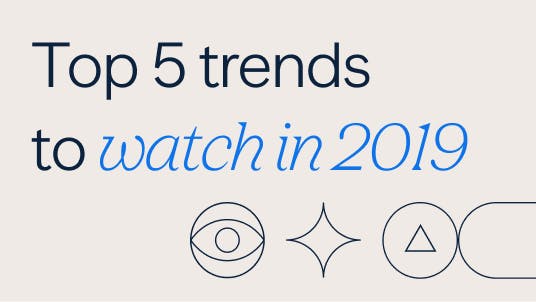
A space where we explore customers ever loftier expectations for easier, faster and more engaging digital experiences. First up: My top 5 Trends to Watch in 2019
Make no mistake: this hits your profits. Many industries are becoming more competitive as digital-first challenger brands keep taking chunks out of established brands’ hallowed ground. Advertisers and technology companies, meanwhile, are upping the stakes: “Interface designers, app-makers and social media firms employ armies of designers to keep people coming back… The now ubiquitous “pull-to-refresh” feature… has turned smartphones into slot machines.”
We have become experts at carving off infinitesimal slices of available attention, to the degree that now, only the most simple, sublime digital experiences can cut the mustard, and cut through the noise.
But cut through we must. To help you plot a competitive digital strategy in 2019, here’s my take on where the biggest gains will be made over the coming year. The 5 key trends to watch are:
- Customer service
- Real-time information
- Marketing personalization
- Design minimalism
- Simpler security
None of these are new in and of themselves, but all have been the subject of popular, profitable recent improvements by pioneering brands. Needless to say, the sooner your brand cottons on, the better your chances of grabbing a slice of the pie.
Customer service gets pre-emptive
Customer service used to be reactive: answering questions, solving problems. Now, it’s evolving into a hotly-competed differentiator, as digital-first brands take advantage of new technologies to create new customer value, and new profit centres, at relatively low cost. The bleeding edge of this trend is in banking. Monzo’s and Starling’s apps both offer services such as real-time balance updates and budgeting tools, which seem basic, but aren’t on offer from many of the traditional banks.
Monzo CEO Tom Bloomfield explains,
“…it’s about visibility and control. It’s the feeling that: ‘With my old bank I never knew how much money I had at any point and I’d spend over a weekend and on Monday morning all the charges would hit my account and I’d realise I’d overspent and it caused me anxiety and stress.”
The same is happening in other sectors. In delivery, for instance, DPD has eked out a sizable share of the delivery market by allowing customers to track and reschedule deliveries via an app. Artificial intelligence is also finding its feet in customer service. Chatbots – which became ubiquitous through 2018 – are maturing into a pre-emptive marketing channel.
The Facebook Messenger bot deployed by the airline KLM is a great example. It responded to 1.4 million queries in its first year; but above and beyond customer service, the app also issues personalised offers based on user data. This isn’t a drastic departure from a non-digital customer service trend. Employees of Ritz-Carlton Hotels (and now many others) are permitted to spend up to $2,000 to avert a negative customer experience.
But in reality, most of us can be easily delighted for much less than $2k. Through 2019, technology will help brands achieve more with their customer service: not only reducing the staffing cost of reactive problem solving, but creating new profit centres with exciting, pre-emptive offerings for consumers to value and enjoy.
Information at the speed of life
One of the most basic customer services is information. And it has now become to be expected in real-time, and the most exciting developments in 2019 will see clever brands manipulating this into an opportunity to keep customers switched on. Uber – which has been telling us in real-time where our driver is for years – currently promotes its trip-tracking service as a safety feature for families.
The ad copy reads:
“Now your teen can get a ride in minutes . You’re with them every step of the way . And everyone gets more from their day”
Without this reassurance, busy parents may prefer to be the taxi service themselves. The question for brands is how they provide this information: through proprietary digital properties, or via a third party? Proprietary properties have their own benefits – not least, the flow of real-time information becomes two-way. ScS, a furniture store, recorded +57% footfall after drawing on real-time location data from consumers’ devices in order to hit them with ads at most opportune times.
Many brands, however, are turning to third-party instant messaging channels. The Four Seasons hotel chain operates customer service via instant messaging through the customer’s interface of choice: Messenger, WeChat, Line, you name it - as well as its own proprietary app. I personally love this approach and am often pitching brands to engage with their customers in channels where they already are. We’re currently working on three Messenger bot proof of concepts and I expect many more to follow over the next 12 months.
It’s noticeable, though, that all the information (as to oppose to services) on offer could easily be obtained by a customer via Google; even the hotel’s breakfast hours are available online. This is the risk of the piggybacking approach. Marketing professor Scott Galloway has warned that big tech poses an existential risk to brands.
“The decline of brand began with the advent of Google. Every day, fewer and fewer people put a prefix of a brand’s name in the Google search bar, and the same is going to happen with voice commands.”
The likes of Google have already made themselves indispensable by dominating digital consumers path to purchase, and their communications online. The challenge for consumer brands is to ensure that they retain the benefits of real-time information – and don’t allow big tech firms to own their customer experiences as well."
Marketing personalization means making yourself useful
‘Marketing personalization’ is an over-used term. Inbound marketing and dynamic content - showing different content to website users and email recipients based on website cookies or purchase history - have become par for the course in recent years.
But really, this is just segmentation: more or less the same as department store signage pointing you towards the menswear department.In 2019, true personalization will evolve from showing people pictures of things they might want to buy, to giving them a reason to invest in a relationship with the brand.The best way to do this is to make yourself useful.Asos has launched an artificial intelligence-powered “style match” service which makes outfit suggestions based on consumers’ uploaded pictures of their existing wardrobes.
The brand believes this contributed to a 26% improvement in sales in the last year, despite an overall drop in marketing spend.Strategies such as this open up new opportunities for previously marketing-light industries. Proctor & Gamble – previously a relatively invisible holding group brand – launched HairCode, an app where customers receive personalised product recommendations based on their hair type. There are two major evolutions in personalization to watch in 2019. One of them is the monetized personalisation trend: where consumers pay for a premium, personalized service.
L’Oreal’s Kiehl cosmetics brand has found success by texting subscribers with reminders to restock, using artificial intelligence figure out when and how often to issue comms. The other – which will play out over the next few years – is the arrival of marketing segmentation at above-the-line advertising channels.
Sky is building its own supply-side platform so that it can sell ad spots in real-time, based on customer impressions, rather than old-fashioned time slots. Similarly, out-of-home (OOH) real-estate is soon to be sold programmatically. Google has even had to deny rumours that it intends to target OOH ads based on mobile data. Both evolutions have strengths and weaknesses. With subscriptions: questions remain around how much customers actually want a close personal relationship with the humdrum paraphernalia of daily life. One Instagrammer interviewed by 1843 magazine complained, “My issue with the Pink Parcel is it’s mainly just tampons”.And quite how segmented ATL may mature into a truly personalized channel remains to be seen.
Whatever happens, brands ought to innovate continually and carefully around ways to increase relevancy to customers on a personal level. Cookie-based targeting led to a surge in digital advertising that consumers found profoundly irritating.True personalization must be the antidote to this problem, creating a utility around brand marketing that not only maximises your customer’s spend, but regains their trust as well.
Less is more: minimalism dominates digital design
The attention economy is placing pressure on digital design, as brands increasingly find themselves punished financially for clunky, outdated user interfaces – and rewarded for putting things right. In 2015, a taxi driver quipped with the incoming COO of Singapore’s DBS bank that the acronym stood for “Damn Bloody Slow”. By end of 2017, the brand claimed to have saved 250m wasted customer hours a year by “shaving minutes and hours out of every process and interaction.”
“DBS improved its cost-income-ratio from 45.4% in 2015 to 43% in 2017. Revenues have also increased by 10.4% over the same period. Meanwhile, the proportion of customers in Consumer and SME Banking in Singapore and Hong Kong that are digital rose nine percentage points since 2015 to 42% today.”
This is not simply a question of aesthetics; the value of digital design minimalism has been tested. A Google study revealed that it takes just seventeen milliseconds for a user to form a negative opinion of complicated websites. If you’re looking for inspiration, you could do worse than look at Readdle’s Spark, an email client designed specifically with attention-poor users in mind.
Readdle’s blog explains,
“Email is still the same as it was 25 years ago. However, as it’s grown in adoption, so have the demands and volume of email. That has ultimately placed a huge burden on its users. People feel overwhelmed and not in control.”
For all its minimalism, Spark is highly functional. Bells and whistles include a very useful collaborative working function, as well as easy integrations with various apps – none of which intrude as you navigate core functionality. The slick aesthetic speaks for itself.
This is important, because the near future will see ever-more of our lives lived out digitally. Digital customer service has become ubiquitous, and brands are jumping onto our messaging apps. The American B2B ecommerce market will reach $1.2 trillion by 2021 – double the size of the B2C market - as SaaS becomes ever-further engrained in the workplace. And until robots finally steal our jobs, we will – according to one prediction by Goldsmith’s University - undergo decades of “automation augmentation” in which professionals and intelligent machines work side-by-side in order to accomplish greater efficiencies. As digital life becomes ever-more chaotic, design minimalism will be critical to staying afloat.
Online security: make it simple, or get hacked
Consumers and brands have been very ineffectual partners in the battle against cybercrime.That’s not to say progress hasn’t been made; Monzo, in particular, has led the charge by making security simpler for customers. The challenger bank shouts about how easy it is to block/unblock a lost credit card…  …whilst behind the scenes it operates a fraud-detection system powered by machine learning. The brand also did a good job of detecting a Ticketmaster breach earlier this year. One key trend of 2019 will see some brands following in Monzo’s footsteps – but simpler UX is only one piece of the puzzle. Consumers find transaction security cumbersome and dull, and new security protocols, however simple, have not achieved market saturation.
A study by Indiana University indicated that two-factor authentication (2FA) had proven unpopular because many consumers simple didn’t see the point; their passwords were, they thought, strong enough. And while Monzo’s extra back-end security is the least you’d expect from a bank, one can’t really expect the same of retailers and travel brands, which store reams of data, and do a very poor job of protecting it.‘A key source of stolen card credentials remains persistent compromises of merchants who store card numbers along with customer details on their own systems as illustrated by hacks against Target, Equifax, Heartland and most recently Marriott.’
The underlying problem, and the underlying complexity, seems most likely to be solved by a bigger problem of digital identity. MasterCard has entered into a strategic Microsoft as-yet vague service “that would allow individuals to enter, control and share their identity data their way – on the devices they use every day”.
VISA is also working on a competing solution.This follows in the footsteps of Estonia’s much-lauded national identity scheme, under which ‘all residents have electronic ID cards, which are used in health care, electronic banking and shopping, to sign contracts and encrypt e-mail, as tram tickets, and much more besides—even to vote…’
Card issuers are well placed to tackle this problem. They have reach and consumer trust on their side; 96% of the UK population has a debit card. This should, in turn, enable standardisation and mass adoption of a truly simple online security protocol. Something like the card PIN code, already used for offline transactions, holds promise; indeed, that’s how Estonia’s system operates. This may also open up marketing opportunities.
Mobile payments in-store are still only popular with 3-7% of western consumers, and only a quarter appear willing to try. If digital payments became viewed as being as safe, or safer, than card transactions, they may become used for offline shopping as well. This should also open up further marketing opportunities via the customer’s device: location based-targeting, beacons, push-notifications, personalised offers, etc.Brands will need to make sure they still benefit from the data created by third-party managed transactions. If they do, this should unlock a simpler, safer and more profitable future for all.
Sleep with one eye open
If I could offer one piece of advice to any brand, it’s to keep an eye on your digital-savvy competition. Step-changes in digital UX rarely happen quietly. Barely a week passes without the press latching on to some new innovation. Supplier press releases and case studies keep journos on their toes. The importance of a self-consciously competitive approach cannot be understated. Only the paranoid will survive.
The chunks of market share taken out of banking by Monzo, out of delivery by DPD, out of entertainment by Netflix and Spotify, out of news by Facebook… Recent history dictates that if your digital experience does not improve, somebody else’s will leave yours in the dust, and take your customers along for the ride. Caution is a must; flurries of digital innovation have created very bad customer experiences in the past.
Media advertising, in particular, spawned ad-blocking and fake news, whilst the blossoming cybercrime industry shows that greater digitalisation comes hand in hand with new problems to solve. Even Facebook’s famous “move fast and break things” motto was retired in 2014 in favour of “move fast with stable infra”. But equally, caution cannot get in the way of innovation, and brands should be prepared to take small risks – suitably controlled by data, research and analytics – in order to break new ground.
It’s not possible to say who 2019’s biggest winner will be in digital design, but one thing’s for sure. With real, profitable improvements falling thick and fast around us, you certainly wouldn’t want to be the brand that stood still.
Watch this space for more from our Great Expectations series. Over and out.



















